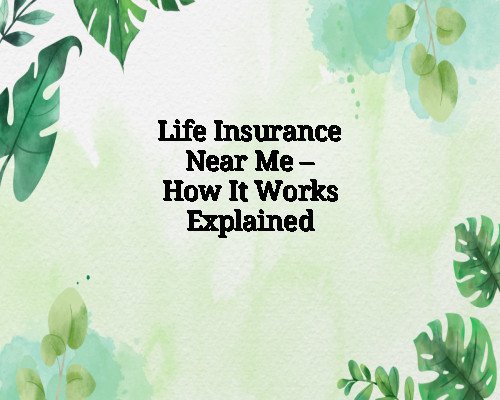Life Insurance Near Me – How It Works Explained
Find out how life insurance works, what types are available, and how to choose the right policy near you to protect your loved ones financially.
Understanding the Basics of Life Insurance
Life insurance is a contract between you and an insurance company. In exchange for regular premium payments, the insurer promises to pay a lump sum—called a death benefit—to your beneficiaries upon your death. This financial safety net can help cover funeral expenses, pay off debts, support your family’s living costs, and secure future goals like education.
Why Life Insurance Matters
Life insurance isn’t just for the elderly or the wealthy. It plays a crucial role in personal financial planning for anyone who has dependents or financial obligations. Whether you’re a young parent, a business owner, or nearing retirement, life insurance ensures your loved ones won’t suffer financially if something happens to you.
Key Components of a Life Insurance Policy
Understanding the core parts of a life insurance policy helps you choose wisely. Here’s a breakdown of the primary elements:
1. Premiums
Premiums are the payments you make to keep your policy active. These can be monthly, quarterly, or annually. The amount depends on factors like age, health, coverage amount, and the type of policy.
2. Death Benefit
This is the amount paid out to your beneficiaries when you pass away. You can choose the death benefit based on your family’s needs, debts, and financial goals.
3. Policy Term
The term is the length of time the coverage is active. Some policies are temporary (term life), while others are permanent (whole life or universal life).
4. Beneficiaries
You choose who receives the death benefit. It can be one person, multiple people, or even a trust or organization.
Types of Life Insurance
There are several types of life insurance policies, each designed for different financial goals and life stages.
Term Life Insurance
-
Best for: Affordable, temporary coverage
-
Features: Offers coverage for a fixed term (10, 20, or 30 years). If you die during the term, your beneficiaries receive the payout.
-
Pros: Lower premiums, simple to understand
-
Cons: No cash value, coverage ends after term unless renewed
Whole Life Insurance
-
Best for: Lifelong coverage with cash value growth
-
Features: Permanent coverage with fixed premiums. Part of your premium goes into a savings component that grows over time.
-
Pros: Builds cash value, stable premiums
-
Cons: Higher premiums than term life
Universal Life Insurance
-
Best for: Flexible premiums and death benefits
-
Features: Offers adjustable coverage and savings growth linked to interest rates.
-
Pros: Flexibility to change payments and coverage
-
Cons: Complex terms, variable returns on cash value
Final Expense Insurance
-
Best for: Covering funeral and small debts
-
Features: A type of whole life policy with a small death benefit, often marketed to seniors.
-
Pros: Easy to qualify, affordable
-
Cons: Limited coverage, higher cost per dollar of coverage
How to Find Life Insurance Near You
Looking for life insurance providers locally helps you get personalized advice, especially when it comes to medical underwriting and state-specific rules.
Use Local Insurance Agents
Local agents understand the market conditions in your area. They can help compare policies from multiple insurers and ensure you get the best value.
Search Online with Geolocation
Use online tools like Google, Yelp, or insurance aggregator websites. Searching “life insurance near me” will yield a list of local offices, customer reviews, and directions.
Visit Financial Institutions
Many banks and credit unions partner with insurance companies. They may offer exclusive deals to their clients or refer you to trusted local agents.
Factors That Influence Your Life Insurance Rates
Your premium will depend on personal and policy-based factors. Understanding these can help you take steps to get better rates.
Age and Gender
Younger individuals pay lower premiums. Women also typically get better rates due to longer life expectancy.
Health and Medical History
Insurers often require a medical exam. Conditions like diabetes, high blood pressure, or smoking can increase your premiums.
Lifestyle Habits
High-risk hobbies (like skydiving) or occupations (like firefighting) may lead to higher rates or exclusions.
Policy Type and Coverage Amount
Term life is cheaper than whole life. The more coverage you choose, the higher your premium will be.
The Life Insurance Application Process
Knowing what to expect during the application process can speed things up and prevent surprises.
Step 1: Get a Quote
Start by getting a free quote online or from a local agent. Compare rates and features of multiple providers.
Step 2: Complete an Application
You’ll need to provide information about your health, lifestyle, and financial situation.
Step 3: Undergo a Medical Exam (if required)
Depending on the policy, you might need a physical exam, lab tests, or a review of your medical records.
Step 4: Wait for Approval
Underwriting can take a few days to a few weeks. Simplified issue or guaranteed issue policies skip the medical exam for faster approval.
Step 5: Pay Your Premium and Activate Coverage
Once approved, pay your first premium to make the policy active. From that point on, your loved ones are protected.
When and Why to Review Your Policy
Life changes—so should your life insurance. Review your policy regularly and after major life events such as:
-
Marriage or divorce
-
Birth or adoption of a child
-
Buying a home
-
Significant changes in income
-
Starting or closing a business
You may need to adjust your coverage, change beneficiaries, or switch to a different policy type.
Common Life Insurance Myths Debunked
Let’s clear up some common misconceptions:
“Life insurance is too expensive.”
Term life policies are very affordable, especially for young and healthy people. You can get significant coverage for less than the cost of daily coffee.
“I’m young, I don’t need it yet.”
Life insurance is cheapest when you’re young and healthy. Buying early locks in low rates for years to come.
“Stay-at-home parents don’t need coverage.”
Even without a paycheck, their contribution is valuable. Insurance can help cover childcare and household needs if something happens.
“Only the breadwinner needs life insurance.”
Both partners contribute to the household—financially or otherwise. Insurance protects your family’s full support system.
Tips for Choosing the Right Life Insurance Policy Near You
Making the right choice involves both research and professional guidance. Here’s how to get started:
1. Assess Your Financial Needs
Estimate your family’s expenses, debt, education costs, and long-term financial goals.
2. Choose the Right Policy Type
Select between term and permanent based on how long you need coverage and your financial flexibility.
3. Compare Multiple Quotes
Never settle for the first offer. Get quotes from at least three providers for the best deal.
4. Work with a Trusted Local Agent
A local expert can guide you through the fine print, helping you understand exclusions, riders, and renewal terms.
5. Read Reviews and Verify Licensing
Check online reviews and confirm that the insurer or agent is licensed in your state.
Conclusion: Life Insurance Is a Smart Financial Step
Life insurance gives peace of mind and protects your loved ones’ future. With a clear understanding of how it works and guidance from local providers, you can confidently choose a policy that meets your needs and budget. Don’t wait until it’s too late—start exploring life insurance near you today.

